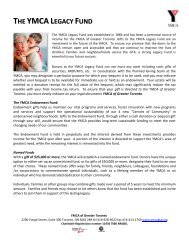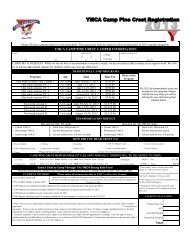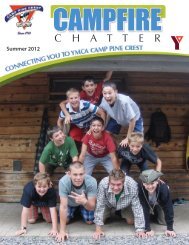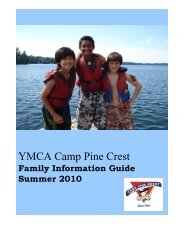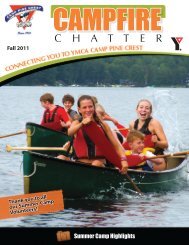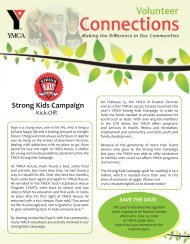2013 Summer Camp Welcome Guide - YMCA of Greater Toronto
2013 Summer Camp Welcome Guide - YMCA of Greater Toronto
2013 Summer Camp Welcome Guide - YMCA of Greater Toronto
- No tags were found...
You also want an ePaper? Increase the reach of your titles
YUMPU automatically turns print PDFs into web optimized ePapers that Google loves.
Swim testA major part <strong>of</strong> orientation day is for each camper to complete their swim test atthe swim docks. This is a mandatory evaluation <strong>of</strong> swim levels to ensure thatstaff are prepared to support campers at all levels. Cabin groups learn aboutthe expectations on the waterfront from the waterfront area heads and thencomplete as much <strong>of</strong> the swim test as they can.Level Able to Swim ColourABC10 lengthsTread water for 2 minutes6 lengthsTread water for 2 minutes2 lengthsTread water for 1 minuteWhiteBlueGreenD Less than 2 lengths RedRed-tag swimmers are considered non-swimmers and must wear a PFD whileswimming. <strong>Camp</strong>ers may try to achieve the next level at any time during thesession under the supervision <strong>of</strong> their counsellors.On the second day <strong>of</strong> camp, all campers receive a “buddy number” for the session,as well as a coloured chip for a necklace to signify their swimming level for ourlifeguards. The necklaces are to remain on each camper for the entire session sowe can ensure immediate recognition <strong>of</strong> specific skill levels when campers enterthe waterfront.The “buddy number” is the check-in and check-out system for our boating andswimming activities. This system ensures that all children and staff are accountedfor while at the waterfront. Each camper will receive their number on the first dayand will use it for the remainder <strong>of</strong> the session when they go to the waterfront. Ifthey forget their number, our lifeguards will assist them.Dunk testJust like the swim test, on orientation day, campers complete what we call a “dunktest” to see how comfortable they are in boats. This test prepares campers for thepossibility <strong>of</strong> “dunking” and keeps them calm and collected if they happen to tip.Staff will be in the water with children that are more nervous. Counsellors workwith campers to explain the process to them and make it fun as well.Every camper and staff wear PFDs while in boats, on sail boards and, for smallerchildren, while snorkelling. This is a camp-wide rule for both safety and positiverole modelling.18





